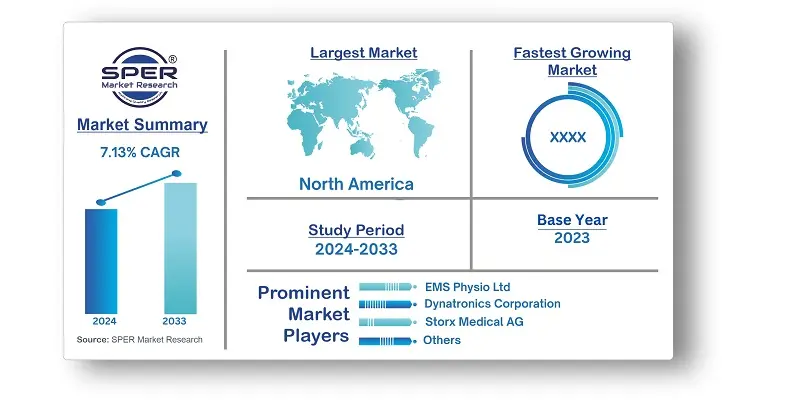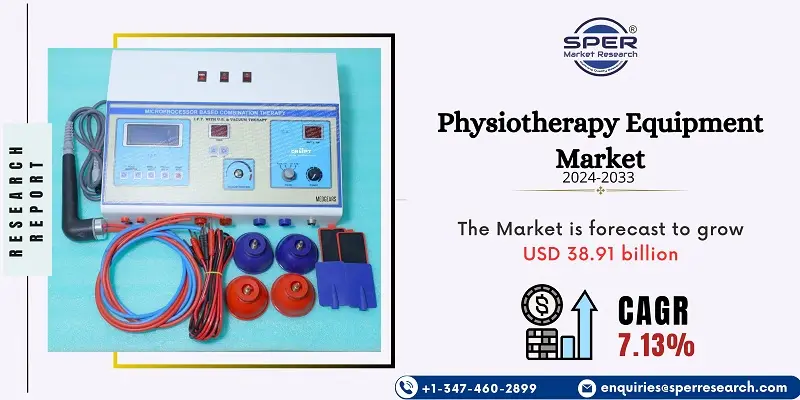
Physiotherapy Equipment Market Trends, Share, Size, Demand, Revenue and Future Outlook
Physiotherapy Equipment Market Growth, Size, Trends Analysis- By Product, By Equipment Type, By Application, By End User- Regional Outlook, Competitive Strategies and Segment Forecast to 2033
| Published: Nov-2024 | Report ID: MEDE2457 | Pages: 1 - 234 | Formats*: |
| Category : Medical Devices | |||
- Siemens Healthineers introduced the ACUSON Maple Ultrasound System in November 2023, which has 25 new features and 15 transducers to improve user experience and streamline procedures. The system's AI-powered tools, along with an inbuilt battery that offers up to 75 minutes of unconnected scanning, enable clinicians to boost efficiency by enhancing consistency in repetitive tasks.
- In March 2023, the physiotherapy unit at District Hospital in Chhattisgarh, India, received sophisticated equipment such as a TENS machine, IFT muscle stimulator, traction machine, SWD, static bicycle, and cordysafe chair to treat severe cases of chronic back pain and stiffness.


| Report Metric | Details |
| Market size available for years | 2020-2033 |
| Base year considered | 2023 |
| Forecast period | 2024-2033 |
| Segments covered | By Product, By Equipment Type, By Application, By End User |
| Regions covered | North America, Asia-Pacific, Latin America, Middle East & Africa and Europe |
| Companies Covered | BTL, EMS Physio Ltd, Dynatronics Corporation, RICHMAR, Performance Health, Storx Medical AG, Zimmer MedizinSysteme GmbH, ITO Co., Ltd, Enraf-Nonius B.V, Whitehall Manufacturing. |
- Hospitals and Clinics
- Rehabilitation Centers
- Sports and Fitness Centers
- Home Care Settings
- Elderly Population
- Athletes and Sports Professionals
- Physiotherapists and Healthcare Practitioners
- Patients with Chronic Pain and Disabilities
- Orthopedic and Neurological Patients
- Post-Surgical Recovery Patients
- Pediatric and Geriatric Care Providers
| By Product: | |
| By Equipment Type: | |
| By Application: | |
| By End User: |
- Global Physiotherapy Equipment Market Size (FY’2024-FY’2033)
- Overview of Global Physiotherapy Equipment Market
- Segmentation of Global Physiotherapy Equipment Market By Product (Laser Therapy Equipment, Continuous Passive Motion Devices, Transcutaneous Electrical Neural Stimulator, Interferential Stimulator, Electrical Muscle Stimulator, High Voltage Pulsed Galvanic Stimulator, Ultrasound Therapy Equipment, Traction Equipment, Diathermy Equipment, Exercise Equipment)
- Segmentation of Global Physiotherapy Equipment Market By Equipment Type (Cryotherapy, Hydrotherapy, Electrotherapy, Continuous Passive Motion Units, Multi-exercise Therapy Unit, Heat Therapy, Ultrasound Physiotherapy, Other)
- Segmentation of Global Physiotherapy Equipment Market By Application (Neurological, Musculoskeletal, Cardiovascular and Pulmonary, Others)
- Segmentation of Global Physiotherapy Equipment Market By End User (Hospitals, Rehabilitation Centers/Clinics, Homecare Settings)
- Statistical Snap of Global Physiotherapy Equipment Market
- Expansion Analysis of Global Physiotherapy Equipment Market
- Problems and Obstacles in Global Physiotherapy Equipment Market
- Competitive Landscape in the Global Physiotherapy Equipment Market
- Impact of COVID-19 and Demonetization on Global Physiotherapy Equipment Market
- Details on Current Investment in Global Physiotherapy Equipment Market
- Competitive Analysis of Global Physiotherapy Equipment Market
- Prominent Players in the Global Physiotherapy Equipment Market
- SWOT Analysis of Global Physiotherapy Equipment Market
- Global Physiotherapy Equipment Market Future Outlook and Projections (FY’2024-FY’2033)
- Recommendations from Analyst
1.1. Scope of the report1.2. Market segment analysis
2.1. Research data source
2.1.1. Secondary Data2.1.2. Primary Data2.1.3. SPER’s internal database2.1.4. Premium insight from KOL’s
2.2. Market size estimation
2.2.1. Top-down and Bottom-up approach
2.3. Data triangulation
4.1. Driver, Restraint, Opportunity and Challenges analysis
4.1.1. Drivers4.1.2. Restraints4.1.3. Opportunities4.1.4. Challenges
4.2. COVID-19 Impacts of the Global Physiotherapy Equipment Market.
5.1. SWOT Analysis
5.1.1. Strengths5.1.2. Weaknesses5.1.3. Opportunities5.1.4. Threats
5.2. PESTEL Analysis
5.2.1. Political Landscape5.2.2. Economic Landscape5.2.3. Social Landscape5.2.4. Technological Landscape5.2.5. Environmental Landscape5.2.6. Legal Landscape
5.3. PORTER’s Five Forces
5.3.1. Bargaining power of suppliers5.3.2. Bargaining power of buyers5.3.3. Threat of Substitute5.3.4. Threat of new entrant5.3.5. Competitive rivalry
5.4. Heat Map Analysis
6.1. Global Physiotherapy Equipment Market Manufacturing Base Distribution, Sales Area, Product Type6.2. Mergers & Acquisitions, Partnerships, Product Launch, and Collaboration in Global Physiotherapy Equipment Market
7.1. Global Physiotherapy Equipment Market Size, Share and Forecast, By Product, 2020-20267.2. Global Physiotherapy Equipment Market Size, Share and Forecast, By Product, 2027-20337.3. Laser Therapy Equipment7.4. Continuous Passive Motion Devices7.5. Transcutaneous Electrical Neural Stimulator (TENS)7.6. Interferential Stimulator (IFT)7.7. Electrical Muscle Stimulator (EMS)7.8. High Voltage Pulsed Galvanic Stimulator (HVPGS)7.9. Ultrasound Therapy Equipment7.10. Traction Equipment7.11. Diathermy Equipment7.12. Exercise Equipment
8.1. Global Physiotherapy Equipment Market Size, Share and Forecast, By Equipment Type, 2020-20268.2. Global Physiotherapy Equipment Market Size, Share and Forecast, By Equipment Type, 2027-20338.3. Cryotherapy8.4. Hydrotherapy8.5. Electrotherapy8.6. Continuous Passive Motion Units8.7. Multi-exercise Therapy Unit8.8. Heat Therapy8.9. Ultrasound Physiotherapy8.10. Others
9.1. Global Physiotherapy Equipment Market Size, Share and Forecast, By Application, 2020-20269.2. Global Physiotherapy Equipment Market Size, Share and Forecast, By Application, 2027-20339.3. Neurological9.4. Musculoskeletal9.5. Cardiovascular and Pulmonary9.6. Others
10.1. Global Physiotherapy Equipment Market Size, Share and Forecast, By End User, 2020-202610.2. Global Physiotherapy Equipment Market Size, Share and Forecast, By End User, 2027-203310.3. Hospitals10.4. Rehabilitation Centers/Clinics10.5. Homecare Settings
11.1. Global Physiotherapy Equipment Market Size and Market Share
12.1. Global Physiotherapy Equipment Market Size and Market Share By Region (2020-2026)12.2. Global Physiotherapy Equipment Market Size and Market Share By Region (2027-2033)12.3. Asia-Pacific
12.3.1. Australia12.3.2. China12.3.3. India12.3.4. Japan12.3.5. South Korea12.3.6. Rest of Asia-Pacific
12.4. Europe
12.4.1. France12.4.2. Germany12.4.3. Italy12.4.4. Spain12.4.5. United Kingdom12.4.6. Rest of Europe
12.5. Middle East and Africa
12.5.1. Kingdom of Saudi Arabia12.5.2. United Arab Emirates12.5.3. Qatar12.5.4. South Africa12.5.5. Egypt12.5.6. Morocco12.5.7. Nigeria12.5.8. Rest of Middle-East and Africa
12.6. North America
12.6.1. Canada12.6.2. Mexico12.6.3. United States
12.7. Latin America
12.7.1. Argentina12.7.2. Brazil12.7.3. Rest of Latin America
13.1. BTL
13.1.1. Company details13.1.2. Financial outlook13.1.3. Product summary13.1.4. Recent developments
13.2. EMS Physio Ltd
13.2.1. Company details13.2.2. Financial outlook13.2.3. Product summary13.2.4. Recent developments
13.3. Dynatronics Corporation
13.3.1. Company details13.3.2. Financial outlook13.3.3. Product summary13.3.4. Recent developments
13.4. RICHMAR
13.4.1. Company details13.4.2. Financial outlook13.4.3. Product summary13.4.4. Recent developments
13.5. Performance Health
13.5.1. Company details13.5.2. Financial outlook13.5.3. Product summary13.5.4. Recent developments
13.6. Storx Medical AG
13.6.1. Company details13.6.2. Financial outlook13.6.3. Product summary13.6.4. Recent developments
13.7. Zimmer MedizinSysteme GmbH
13.7.1. Company details13.7.2. Financial outlook13.7.3. Product summary13.7.4. Recent developments
13.8. ITO Co., Ltd
13.8.1. Company details13.8.2. Financial outlook13.8.3. Product summary13.8.4. Recent developments
13.9. Enraf-Nonius B.V
13.9.1. Company details13.9.2. Financial outlook13.9.3. Product summary13.9.4. Recent developments
13.10. Whitehall Manufacturing
13.10.1. Company details13.10.2. Financial outlook13.10.3. Product summary13.10.4. Recent developments
13.11. Others
SPER Market Research’s methodology uses great emphasis on primary research to ensure that the market intelligence insights are up to date, reliable and accurate. Primary interviews are done with players involved in each phase of a supply chain to analyze the market forecasting. The secondary research method is used to help you fully understand how the future markets and the spending patterns look likes.
The report is based on in-depth qualitative and quantitative analysis of the Product Market. The quantitative analysis involves the application of various projection and sampling techniques. The qualitative analysis involves primary interviews, surveys, and vendor briefings. The data gathered as a result of these processes are validated through experts opinion. Our research methodology entails an ideal mixture of primary and secondary initiatives.



Frequently Asked Questions About This Report
PLACE AN ORDER
Year End Discount
Sample Report
Pre-Purchase Inquiry
NEED CUSTOMIZATION?
Request CustomizationCALL OR EMAIL US
100% Secure Payment






Related Reports
Our Global Clients
Our data-driven insights have influenced the strategy of 200+ reputed companies across the globe.




















